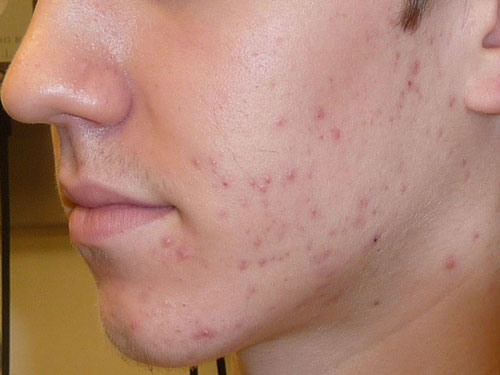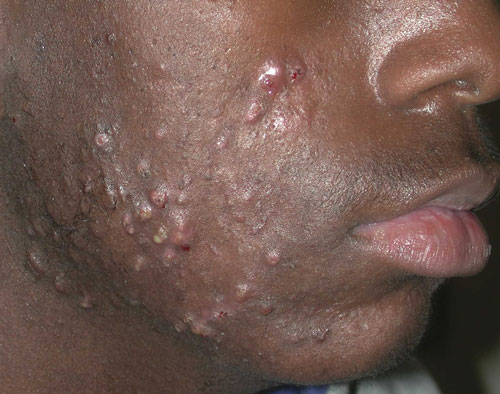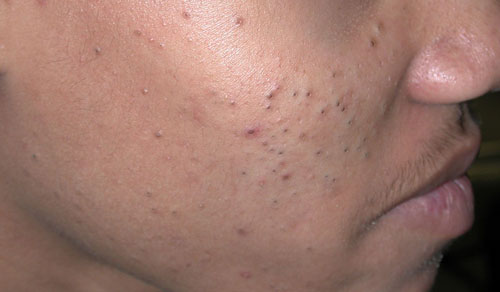By: Sarah Asch, MD, FAAP, FAAD & Matthew Mahoney, DO
Acne, the medical condition that causes "pimples," is common and a normal part of growing up—especially in the teenage years. In fact, around 85% of people have acne when they're teens.
Acne can affect many places on the body, including the face, neck, shoulders, upper back and chest. For some teens, acne is not bothersome. Other teens want to clear up their acne. For some teens, treating acne boosts self-esteem and helps build life skills around self-care. A smaller number of teens have more severe acne that is important to treat to prevent permanent scars.
Thankfully, there are options for everyone to help prevent and treat acne. Here's what you need to know.
What causes acne in teens?
 The hair follicles (pores) in the skin contain oil glands, called sebaceous glands. The oil they produce is called sebum, which helps to lubricate the hair and skin. But changes during puberty can lead to acne:
The hair follicles (pores) in the skin contain oil glands, called sebaceous glands. The oil they produce is called sebum, which helps to lubricate the hair and skin. But changes during puberty can lead to acne:
-
More oil = clogged pores. Increased levels of hormones during the teen years lead to more sebum production. This can cause the pores to become clogged up.
-
Then, bacteria get busy. Unfortunately, a normal, healthy bacteria on the skin named
C. acnes loves all of the extra oil and gets to work multiplying, causing redness and irritation.
What are different types of acne bumps called?
 There are four main types of acne bumps:
There are four main types of acne bumps:
Blackheads. The medical term for these is "open comedones," and they are pores that get clogged up with extra oil. These stay close to the skin's surface and have a top darker than the surrounding skin.
Whiteheads. These are also called "closed comedones," and they are pores that get clogged up with the extra oil, close, and bulge out slightly from the skin's surface.
Pimples. These are the red bumps that form when the extra oil and
C. acnes bacteria combine to clog up a pore more deeply in the skin. Sometimes the bacteria create pus and the red bump becomes a pustule.
Nodules and cysts. These are larger and often painful pimples that extend to the deeper layers of the skin. These are the ones that are most likely to lead to scarring.

How long do pimples last?
Without treatment, a pimple takes about two months to go through its entire cycle, from a little clog to a full-grown pimple and then to go away.
Acne marks & scars
After pimples go away, they often leave a red or brown mark that takes even longer to fade. These marks are called post-inflammatory discoloration. This can be one of the most frustrating parts of acne for many people, but the marks will fade eventually.
Some pimples leave scars. These are indentations of the skin and can be permanent. If you are noticing this type of mark it is important to talk to your doctor about treatment to stop more scars from forming.
What can make acne worse?
 Hormones. As mentioned above, teenage hormones lead to more oil production in the skin, which can lead to acne. Acne can also flare with the hormone increases that happen just before menstrual periods.
Hormones. As mentioned above, teenage hormones lead to more oil production in the skin, which can lead to acne. Acne can also flare with the hormone increases that happen just before menstrual periods.
Diet. The role of diet in acne is not clear. A healthy, well-balanced diet is likely to be better for the skin, just as it is for the health of the rest of the body. Diets high in sugars and simple carbohydrates might contribute more to acne.
Skin care products and cosmetics. Some products, especially oil-based skin care products, can lead to acne if they clog up pores. Water-based or "non-comedogenic" products are less likely to cause acne. Anything that presses on the skin for a long time, including tight clothing or equipment like chinstraps on helmets, can cause worsening acne in that area.
Stress. While
stress doesn't "cause" acne, there is a link between worse acne and stress. Research studies have shown that teenagers tend to have worse acne when school is stressful. Regular exercise, healthy sleep, and supportive relationships all help lower stress.
Key tips to help prevent acne
Wash the skin twice a day. once in the morning and once in the evening. Use a gentle cleanser or soap with warm water and avoid harsh or gritty scrubs.
Do
not scrub the skin with rough cloths or brushes, as this can further irritate the skin. Remember that acne is not caused by dirt on top of the skin but rather by extra oil combined with bacteria inside the skin. It cannot be scrubbed off. Scrubbing can lead to dryness and irritation and make acne worse.
Avoid pinching, popping, or picking at pimples. Manipulating the skin can make acne worse and lead to infections or scarring.
How to treat acne
If you think about what causes acne, you can also guess how to treat it. Remember that extra hormones cause more oil production, which leads to clogged pores. The extra oil combines with C. acnes bacteria to cause redness and irritation. Treatments are aimed at each of these parts of acne.
Types of acne medications
Benzoyl peroxide. This product is available in many acne-fighting products sold without a prescription. It helps to both kill theC. acnes bacteria and reduce some of the oil production. Start with a lower strength (ranging from 3.5%-5%) wash once a day. Benzoyl peroxide can be used on acne anywhere on the body, including as a face wash or in the shower as a body wash for the chest and back. Watch out because benzoyl peroxide will bleach fabrics, so use an old towel and pillowcase. Ensure you completely dry your skin before putting on your favorite clothes.
Hydrocolloid pimple patches. These small stickers are becoming more popular, and can be effective for improving single pimples. They cover and protect the pimple while absorbing oil and bacteria from within it. Some have medications in them which can be irritating if used with other acne medications or washes.
Antibiotics. Antibiotics can be helpful for teens with pimples (either red bumps or pus-filled bumps). They work to kill the acne-causing C. acnes bacteria and help to fight against inflammation too. Doctors use antibiotic creams, lotions, solutions, or gels and antibiotic pills to help with pimples. Your doctor will tell you the details about how to use these.
Topical retinoids. This group of medicines for acne include products named adapalene, tretinoin, and tazarotene. They work to unplug the pores by removing the outermost layer of skin, improving acne. The most significant side effect is dryness of the skin. When first starting to use a retinoid, use it every other day or just a couple of times a week to limit the dryness, then increase how often you use it little by little. Using a moisturizer daily also helps with dryness.
Try the five-dot method for applying retinoid medicine.
Use a small "pea-sized" amount of medication applied in five dots on different parts of the face. Then then rub the medication over the entire face, not just on the pimples you can see. This way you are preventing new pimples from developing.
Hormonal treatments. Certain contraceptive pills and a pill called spironolactone are used for female patients with acne. These pills work to block the effect of hormones in the skin so that there is less oil production and less acne.
Isotretinoin. For really severe acne, especially the kind that leads to scars, a pill called isotretinoin can be used. It works like retinoid creams to decrease the oil produced by the sebaceous glands in the skin. It is highly effective for severe acne and for acne that has not improved with other treatments. It requires close monitoring because taking it during pregnancy can lead to birth defects.
What to keep in mind about acne treatment
Acne takes at least two months to get better
after you start treatment, so do not give up too soon! The red and brown marks left by pimples can take even longer to fade.
There are many effective acne-fighting products available without a prescription, but start using them one by one and little by little to avoid irritating your skin.
If your acne is more severe or causing scars, there are powerful medicines to control it available from your doctor or a dermatologist.
Most of these treatments do not "cure" the condition, and you must keep using the treatment regularly to prevent acne from returning.
Many of these options can lead to dryness and a little skin peeling, so using an oil-free moisturizer every day is helpful.
Sun protection is important to help fade the red and brown marks and to protect against extra sensitivity associated with some treatments. There are some moisturizers with sunscreens in them that can be a good "one-step" option.
Talk with your doctor
Don't hesitate to talk with your pediatrician or pediatric dermatologist for more information about acne or any other health concerns.
More information
About Dr. Asch
 Dr. Sarah Asch, MD, FAAP, FAAD is a member of both the Section on Dermatology and Section on Telehealth within the American Academy of Pediatrics. She is active in pediatric teledermatology and has started her own practice aimed at expanding subspecialty pediatric dermatology care for the rural Upper Midwest, Hometown Pediatric Dermatology. She is involved in the Society for Pediatric Dermatology and volunteers at the American Academy of Dermatology’s Camp Discovery. Dr. Sarah Asch, MD, FAAP, FAAD is a member of both the Section on Dermatology and Section on Telehealth within the American Academy of Pediatrics. She is active in pediatric teledermatology and has started her own practice aimed at expanding subspecialty pediatric dermatology care for the rural Upper Midwest, Hometown Pediatric Dermatology. She is involved in the Society for Pediatric Dermatology and volunteers at the American Academy of Dermatology’s Camp Discovery.
|
About Dr. Mahoney
 Matthew Mahoney, DO is a pediatric resident physician at the University of Minnesota and M Health Fairview Masonic Children’s Hospital. He has a special interest in pediatric dermatology and is a member of the American Academy of Pediatrics Section on Dermatology Education Committee. Matthew Mahoney, DO is a pediatric resident physician at the University of Minnesota and M Health Fairview Masonic Children’s Hospital. He has a special interest in pediatric dermatology and is a member of the American Academy of Pediatrics Section on Dermatology Education Committee.
Acne images courtesy Sarah Stein, MD, FAAD, FAAP
|